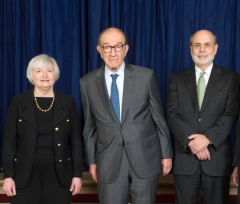In a recent article I advocated for a new way of naming business cycles. The new approach emphasizes the cause rather than the effect. So instead of the “housing bubble” and “financial crisis,” we should refer to the Greenspan-Bernanke Crisis. Here we will turn our attention to the current situation.
The current economy is a puzzle for mainstream economists. Some aspects of the economy seem to be very strong, such as the stock market, real estate, social media, and internet companies. Other aspects of the economy seem to be very weak, such as economic growth, wage increases, and the number of full time “breadwinner” jobs.
One major example of this puzzle is that unemployment is very low and inflation is also very low and yet the Fed and other central bankers appear to be afraid to allow interest rates to go back to their normal levels. They appear to be afraid to make any move, for fear that the economy collapses.
You can understand why. They sat on a housing bubble of their own making and had no idea it existed and was so massive and how entangled it was with the financial sector. At the time, they thought that everything was fine and that they could just lower interest rates if some problem appeared out of the blue. Instead, they had to bring interest rates down to zero and engaged in years of unconventional and untried monetary policies, with very little in the way of positive results. So naturally they are worried. Most are no doubt hoping for the end of their terms as central bankers to come as quickly as possible.
To complicate matters they now have trillions of dollars of government debt and mortgage backed securities on their books. They say they are going to sell off most of these portfolios, but don’t hold your breath. We heard about “green shoots” in the economy and normalized interest rates for years before we actually saw anything happen.
Treasury bond prices have been weakening and interest rates are rising. There is less demand for government bonds from overseas. The dollar is likely to weaken too. To make matters worse, the Fed’s balance sheet is $4.5 trillion, the national debt is $20 trillion, and each 1% rise in interest rates adds $200 billion to the government’s budget deficit.













Leave A Comment